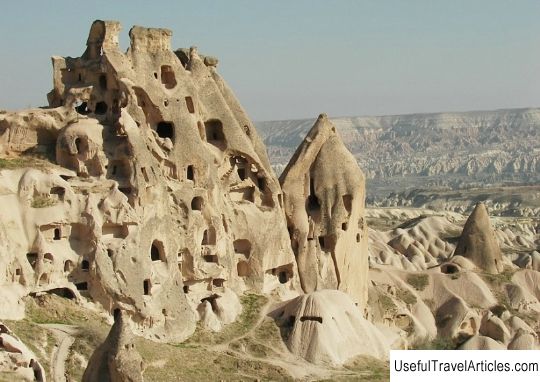Cavusin description and photos - Turkey: Cappadocia
Rating: 8,5/10 (432 votes) 
Cavusin description and photos - Turkey: Cappadocia. Detailed information about the attraction. Description, photographs and a map showing the nearest significant objects. The name in English is Cavusin. Photo and descriptionThe small village of Chavushin is located 6 km northeast of Goreme on the road to Avanos. The village of Chavushin, with a good hotel and several boarding houses, amazes with the remains of a large cave city. Near this settlement, there are many buildings that press against the rocks and continue into them. The back wall, revealing a multi-level system of dwellings, remained from the rocky city after another collapse. The rock, eaten away like a piece of "cheese", can be seen from afar, so it is not difficult to find Chavushin. In this "cheese" people lived in the fifties of the twentieth century. Until 1953 this part of the city was inhabited by Turks living in caves. Christians were expelled from here after the great earthquake, and residents were forbidden to live in caves. Most likely, the collapse was facilitated by the fact that the rock could not withstand the pile-up of new passages and rooms constantly being cut through it. Chandelier hooks on the ceilings testify to the recent presence of people in these caves, as well as house numbers on some caves. At the highest point of Chavushin is the Church of John the Baptist, or as it is called Vaftizci Yahya. This church dates back to the 5th century and is one of the oldest churches in Cappadocia. Inside it is a chain of rooms in caves, semi-vertical passages between different levels, connected by corridors. On the frescoes, you can see scenes from the life of Jesus, Mary, and the apostles. Many of the frescoes are lost, but some fragments can still be seen. They date back to the 7-8 centuries. Here, if you look very closely, you can see a fresco depicting the sacrifice of Abraham. There is a metal staircase leading to the church of Saint John, which was erected after the collapse of the ancient bridge. Into the labyrinth of the cave, "gnawed out" a significant part of the promontory of the rock, you can get behind the church of St. John the Baptist. In it, the rooms are connected in three-dimensional intricate chains no worse than in some underground city. Often the passage to the next room can be in the far corner of the cave in a semicircular depression. You can only see the passage when you find yourself directly in front of it. The tunnel is so chaotic that it can suddenly go into a staircase or a well, or lead to a many-meter cliff, or maybe directly into a cliff if the further road collapses, or into a cave. In the cave, all the entrances are bent several times, so they do not let light through at all, which means that you cannot leave it without a lantern. Lovers of labyrinths will get a lot of pleasure, and not under, but above the ground. On the main street of the village of Chavushin, you can see a rock-cape, which is pitted through and through with the next clusters of caves. It's easier to get close to it from the northern side closest to Avanos. On the far, southern side, there is a tributary valley with unexpectedly high and steep sides occupied by the remains of the buildings of the old Chavushin. Many houses are partially destroyed. Interestingly, this destruction goes from top to bottom: first the roof, then the overlap of residential, upper floors and thin walls. Last of all, the powerful masonry of the lower floor is destroyed, which usually looks like a vaulted semi-basement, parts of which are carved into the rock. A large and deserted city is quite impressive, suddenly opening up from the cliff opposite. In the upper part of the city, a trail begins, passing by the rocks and leading to Zelva, away from all roads and other signs of civilization. It stretches along the mountain, behind which the sun sets in the evening. The inhabitants of the village of Chavushin have already moved from the caves to new modern houses. The local population is hospitable and smiling, but few people know English, and even more so Russian outside of the settlements. This fact will in no way prevent tourists from exchanging greetings and smiles. If you are in the mood for long-term communication, then, most likely, you will find it among the same tourists who come to see these parts. The local cemetery testifies to the extraordinary health of local residents who easily crossed the centenary.      We also recommend reading Ruins of the Church of do Carmo (Convento do Carmo) description and photos - Portugal: Lisbon Topic: Cavusin description and photos - Turkey: Cappadocia. |




